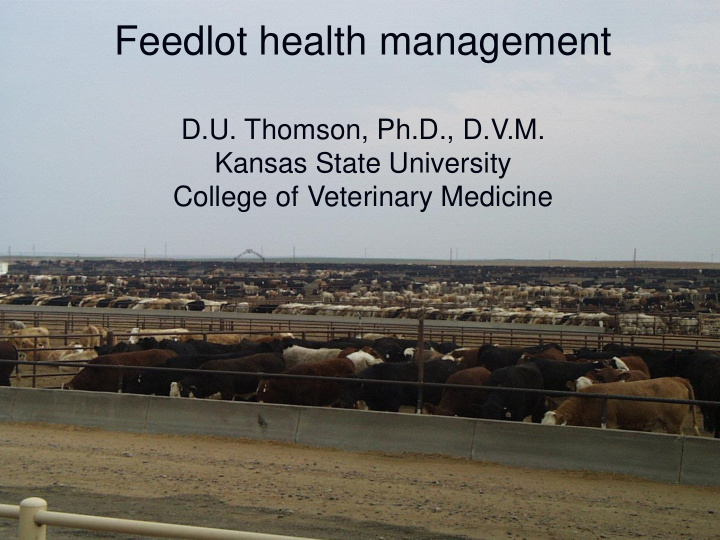



Feedlot health management D.U. Thomson, Ph.D., D.V.M. Kansas State University College of Veterinary Medicine
Why do cattle get sick? Overwhelming dose of pathogen Compromised immune system This causes morbidity!
Common Diseases of Feedyard Cattle Respiratory Disease 16.2% Digestive Disorders 4.3% Atypical Interstitial Pneumonia 2.8% Bullers 2.8% Lameness 1.8% Central Nervous System 1.1% NAHMS 2011 3
“WHICH WAY DID HE GO?
DART
How do you cover the pens? Serpentine fashion Get all the cattle up Cattle will hide at the feed bunk
Water tank Feedbunk
Hay and pen riding
Normals Normal Rectal temperature 101.5 to 103.5 Respiration rates 10 to 40 breaths per minute Heart rates 60 to 80 beats per minute Rumen contractions 1 to 2 contractions per minute
What does this mean?
Common treatment questions Work with your veterinarian! Single or combination antimicrobials? How long to I wait to treat again? Route of delivery and speed to infection? What about ancillary therapy?
Effects of Diet on Ruminal Papillary Development Calf fed long alfalfa hay + concentrates . Papillae from the ventral floor of the cranial sac
Effects of Diet on Ruminal Papillary Development Calf fed concentrates only
Rumen acidosis What are the main causes Rapid intake of a soluble carbohydrate Improper diet change Environmental reasons
Clinical signs of acidosis Sudden death Anorexia Depressed Can have CNS signs Impaired thiamine production Increased respiratory rates Dehydration Diarrhea
22
24
25
Clinical signs of subacute acidosis Cattle go off feed for a couple of days Decreased performance Feed left in bunk Ahead the cattle
Treatment of acidosis Subacute cases Hospital stay with good grass hay in bunk Acute cases Tube with 500 grams of sodium bicarbonate in water Rumen evacuation (drastic)
Sequela to acidosis Bloat Decrease in rumen motility Decrease in eructation Types of bloat Free gas - concentrates Frothy – wheat pasture
Taken from Diseases and Disorders of Cattle, Blowey and Weaver
Treatment of bloat Free gas Pass tube and let down Put on hay Three strikes and they’re out Fistula Frothy bloat Therabloat Breaks up surface tension of froth
Emergency treatment of bloat Bloat needle, knife (lock blade) Stick cattle high on left paralumbar fossa Do not let cattle lay down If they go down they die very quickly
Puncture here Taken from Diseases and Disorders of Cattle, Blowey and Weaver
Lameness 34
Prevention is the key
Factors Infectious causes(%) Non-infectious causes(%) Pen condition 85.0 57.8 Pen surface 56.5 41.5 Weather patterns 45.6 19.7 Cattle Handling 34.7 63.9 (prior to arrival) Cattle Handling (post 28.6 37.3 arrival) Nutrition 27.9 25.2 Cattle temperament 23.8 65.3 Cattle type 15.6 11.6 Insufficient 12.9 8.8 preconditioning Breed 9.5 8.2 Cattle age 4.8 6.8 Terrel et.al Bov. Prac. Vol 48 No. 1 pp 53-60
Footrot Taken from Diseases and Disorders of Cattle, Blowey and Weaver
Toe/Sole Abscess Taken from Diseases and Disorders of Cattle, Blowey and Weaver
Moving Downer Cattle Unacceptable Transportation Methods: -Dragging -Lifting with chains Acceptable Transportation Methods: -Sled -Low-boy trailer -Bucket of a loader
Prognosis Alert downer verses moribund Animal husbandry Shelter, hay and water 24 to 36 hours to show improvement Roll every 6 to 12 hours to prevent compartmentalization Humane euthanasia
Care of Downer Cattle Keys to Proper Care
Thank you, any questions?
Recommend
More recommend